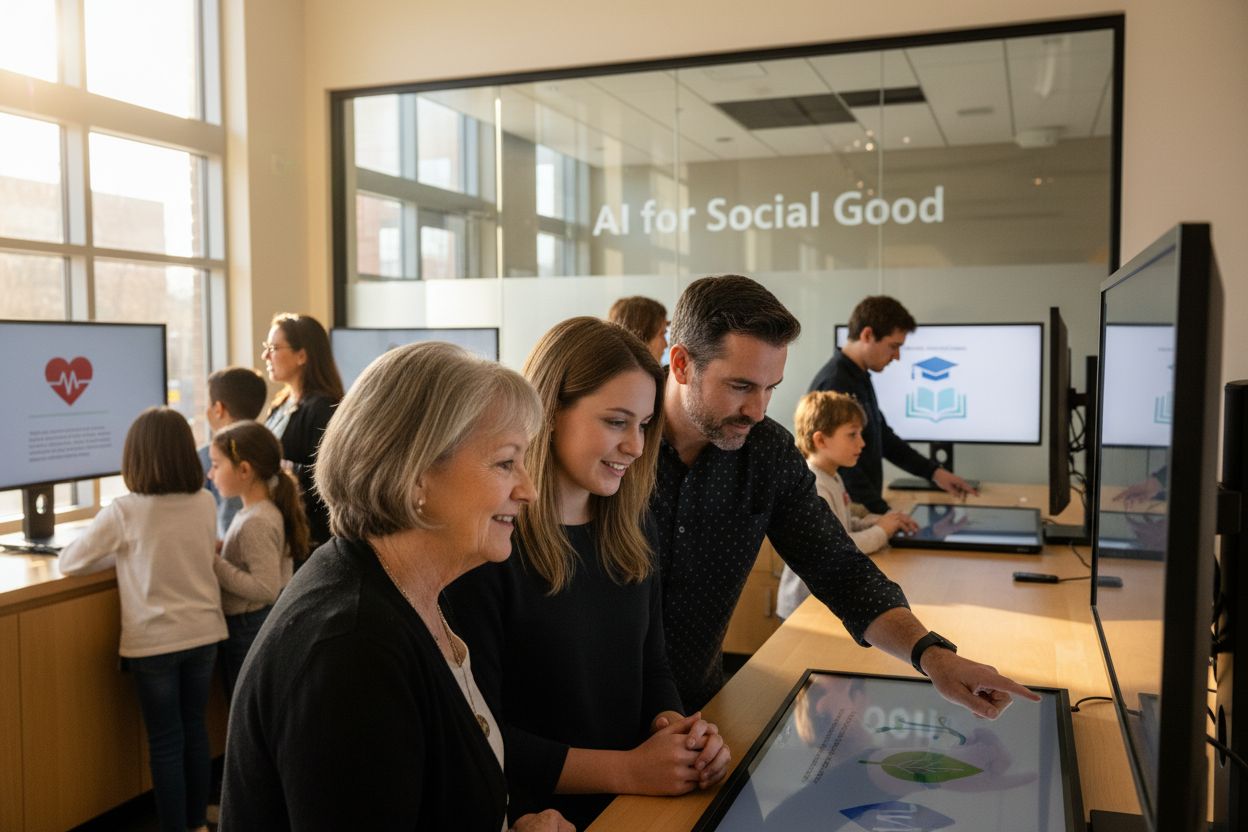
Understanding AI for Social Good Impact and Applications
Understanding AI for Social Good Impact and Applications
AI for social good is changing everything you think technology can do. Most people picture artificial intelligence as something that powers big business or futuristic apps, but that is only half the story. The real surprise is that AI systems are now being used to predict disease outbreaks, improve disaster response, and even personalize education for underserved communities and this is happening right now all over the world.
Table of Contents
- What Is AI for Social Good?
- The Importance of AI for Social Good
- How AI for Social Good Works
- Key Concepts in AI for Social Good
- Real-World Applications of AI for Social Good
Quick Summary
| Takeaway | Explanation |
|---|---|
| AI for social good improves human welfare. | It focuses on using AI to tackle critical global challenges like healthcare and poverty. |
| Ethical frameworks guide AI implementations. | Emphasizing transparency and fairness ensures technology benefits society while protecting individual rights. |
| AI enables innovative solutions for healthcare. | Applications include predictive models for early disease detection and improved patient care in underserved areas. |
| Data-driven approaches enhance environmental monitoring. | AI technologies enable climate change tracking and resource optimization through advanced algorithms and satellite data. |
| Collaboration is key to effective AI development. | Interdisciplinary teamwork among experts helps create AI systems that address real-world social issues successfully. |
What Is AI for Social Good?
AI for social good represents a transformative approach to applying artificial intelligence technologies toward addressing critical global challenges and improving human welfare. Google’s AI for Social Good initiative defines this concept as leveraging advanced computational capabilities to create meaningful, positive societal impacts across multiple domains.
Understanding the Core Concept
At its fundamental level, AI for social good focuses on utilizing machine learning, data analysis, and intelligent systems to solve pressing humanitarian, environmental, and community challenges. Unlike traditional AI applications that prioritize commercial or technological objectives, this approach centers on generating tangible social value. Key focus areas include healthcare accessibility, environmental conservation, educational equity, disaster response, and poverty alleviation.
Practical Applications and Impact
The scope of AI for social good spans numerous critical sectors, demonstrating its potential for widespread positive transformation. Some remarkable examples include:
- Predictive healthcare models that can identify disease outbreaks before they become widespread
- Climate change monitoring systems using satellite imagery and machine learning
- Educational platforms that personalize learning for underserved communities
- Humanitarian aid optimization through intelligent resource allocation algorithms
These applications showcase how AI can be strategically deployed to address complex global challenges. Read more about responsible AI development to understand the ethical frameworks guiding these innovations.
The true power of AI for social good lies not just in technological sophistication, but in its human-centric approach. By prioritizing societal well-being and sustainable development, these AI solutions represent a profound shift from viewing technology as a profit-driven tool to seeing it as a collaborative mechanism for global problem solving.
The Importance of AI for Social Good
The significance of AI for social good extends far beyond technological innovation, representing a critical paradigm shift in how we address global challenges. Stanford University’s Human-Centered AI Institute emphasizes that strategic AI implementation can fundamentally transform our approach to solving complex societal problems.
Addressing Global Challenges
AI for social good provides unprecedented capabilities to tackle issues that traditional approaches have struggled to resolve. By leveraging advanced computational technologies, we can now develop more nuanced, data-driven solutions to systemic challenges. This approach enables more precise, targeted interventions across multiple critical domains where human resources and traditional methods have significant limitations.
Transformative Potential Across Key Sectors
The importance of AI for social good becomes evident when examining its potential impact across various critical sectors:
- Healthcare: Enabling early disease detection and personalized treatment strategies
- Environmental Conservation: Supporting climate change monitoring and biodiversity preservation
- Educational Access: Creating adaptive learning platforms for underserved communities
- Humanitarian Support: Optimizing resource allocation during crisis management
These applications demonstrate how AI can serve as a powerful tool for creating meaningful social impact.
To clarify the unique focus and impact of AI for social good across major sectors, the following table organizes the primary application domains and the specific benefits AI delivers in each.
| Sector | Example Applications | Social Impact |
|---|---|---|
| Healthcare | Early disease detection, personalized care | Improves accessibility and patient outcomes |
| Environmental | Climate change tracking, biodiversity monitoring | Enhances conservation and sustainability efforts |
| Education | Adaptive learning platforms for underserved communities | Promotes equitable educational opportunities |
| Humanitarian Aid | Disaster response optimization, resource allocation | Increases efficiency and life-saving interventions |
| Agriculture | Crop monitoring, yield prediction | Supports food security and sustainable practices |
Explore my comprehensive guide on ethics in AI to understand the responsible development principles guiding these innovations.
Ultimately, AI for social good represents more than technological advancement. It embodies a profound commitment to using computational intelligence as a collaborative mechanism for addressing humanity’s most pressing challenges, transforming potential limitations into opportunities for sustainable, equitable progress.
How AI for Social Good Works
The implementation of AI for social good involves a sophisticated, multidimensional approach that transforms complex data and advanced algorithms into actionable solutions for critical societal challenges. MIT Technology Review highlights the critical methodological strategies that enable these transformative technologies.
Data Collection and Processing
AI for social good begins with comprehensive and ethical data gathering, leveraging multiple sources including satellite imagery, public health records, environmental sensors, and community-reported information. These diverse data streams are meticulously processed using advanced machine learning techniques that can identify patterns, predict outcomes, and generate insights far beyond human analytical capabilities.
Algorithmic Design and Implementation
The core mechanism of AI for social good involves developing specialized algorithms designed to address specific social challenges. These algorithms are distinguished by their focus on:
- Maximizing societal benefit over commercial profit
- Ensuring transparent and interpretable decision making
- Maintaining robust ethical guidelines
- Protecting individual privacy and data rights
For instance, an AI system designed for disaster response might integrate real-time geographical data, population movement patterns, and infrastructure information to optimize emergency resource allocation. Learn more about collaborative AI development to understand how these complex systems are created.
The implementation process requires continuous monitoring, refinement, and interdisciplinary collaboration. Experts from fields like data science, social work, public policy, and domain-specific research work together to ensure that AI solutions are not just technologically sophisticated, but genuinely effective in creating meaningful social impact.
Key Concepts in AI for Social Good
ACM Digital Library highlights the fundamental principles that distinguish AI for social good from traditional technological applications. These key concepts represent a transformative approach to developing and implementing artificial intelligence with profound societal impact.
Ethical Framework and Design Principles
AI for social good is fundamentally grounded in a robust ethical framework that prioritizes human welfare over technological complexity. This approach demands a comprehensive consideration of potential societal implications, moving beyond traditional technological metrics to evaluate impact through social benefit, inclusivity, and long-term humanitarian outcomes.
Core Conceptual Foundations
The key concepts driving AI for social good encompass several critical dimensions:
- Transparency: Ensuring algorithmic decisions can be understood and scrutinized
- Fairness: Developing systems that do not perpetuate existing social inequalities
- Accountability: Creating mechanisms for responsibility and potential remediation
- Human-Centered Design: Prioritizing human needs and experiences in technological solutions
Explore the principles of artificial intelligence to gain deeper insights into these foundational concepts. These principles are not merely theoretical constructs but practical guidelines that shape how AI technologies are conceptualized, developed, and deployed in real-world social contexts.
This table summarizes the core ethical principles and conceptual foundations that guide the development and deployment of AI for social good, highlighting their significance and focus.
| Principle | Description | Focus Area |
|---|---|---|
| Transparency | Ensuring AI decisions are understandable and open to scrutiny | Algorithmic interpretability |
| Fairness | Designing systems to avoid reinforcing social inequalities | Equitable outcomes |
| Accountability | Enabling responsibility and remediation for AI-driven decisions | Governance and oversight |
| Human-Centered Design | Prioritizing user needs and community impact | Societal benefit and user welfare |
| Privacy & Data Rights | Protecting individual information and respecting consent | Data stewardship |
Ultimately, key concepts in AI for social good represent a paradigm shift from viewing technology as a standalone solution to understanding it as a collaborative tool for addressing complex societal challenges. This approach demands continuous dialogue, interdisciplinary collaboration, and a commitment to using technological capabilities in service of broader human welfare.
Real-World Applications of AI for Social Good
United Nations Development Programme highlights the transformative potential of AI technologies in addressing global challenges across multiple critical domains. These real-world applications demonstrate how intelligent systems can create tangible, measurable social impact.
Healthcare and Medical Interventions
AI technologies are revolutionizing healthcare delivery and medical research by enabling unprecedented diagnostic capabilities, predictive health modeling, and personalized treatment strategies. From early disease detection algorithms to complex medical imaging analysis, these applications help bridge healthcare accessibility gaps in underserved communities, potentially saving countless lives through advanced technological interventions.
Environmental and Humanitarian Solutions
AI for social good extends its impact across diverse domains, offering innovative solutions to complex global challenges:
- Climate change monitoring through satellite imagery and predictive modeling
- Disaster response optimization using real-time geographical data
- Agricultural productivity enhancement for sustainable food security
- Wildlife conservation through advanced tracking and protection systems
Explore open source contributions in AI development to understand how collaborative technologies drive these transformative solutions. These applications demonstrate AI’s capacity to address systemic challenges by providing data-driven, scalable interventions that traditional approaches cannot effectively implement.
By focusing on human-centric technological solutions, these real-world applications prove that artificial intelligence can be a powerful tool for creating meaningful, sustainable social progress across global communities.
Take the Next Step Toward Real-World AI for Social Good
Want to learn exactly how to design AI systems that deliver measurable social impact? Join the AI Engineering community where I share detailed tutorials, code examples, and work directly with engineers building AI-driven social good solutions.
Inside the community, you’ll find practical, results-driven AI for social good strategies that actually work for growing companies, plus direct access to ask questions and get feedback on your implementations.
Frequently Asked Questions
What is AI for Social Good?
AI for social good refers to the application of artificial intelligence technologies to address critical global challenges and improve human welfare across various domains, such as healthcare and environmental conservation.
How does AI for Social Good address global challenges?
It leverages advanced computational technologies to develop data-driven solutions for systemic issues, enabling more precise interventions in areas where traditional methods are limited.
What are some real-world applications of AI for Social Good?
AI is used in sectors like healthcare for predictive health modeling, in environmental conservation for climate monitoring, and in educational access through personalized learning platforms for underserved communities.
What ethical considerations are involved in AI for Social Good?
Key ethical guidelines include ensuring transparency in algorithmic decisions, promoting fairness to avoid perpetuating social inequalities, and prioritizing human welfare in the design and implementation of AI systems.
Recommended
- Understanding Responsible AI Development and Its Impact
- Understanding Ethics in AI - A Comprehensive Guide
- Understanding Open Source in AI - Key Concepts Explored
- Zen van Riel - Senior AI Engineer | AI Engineer Blog
